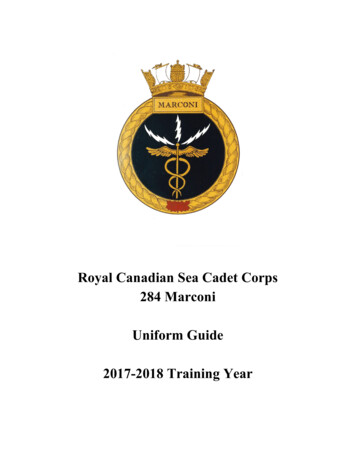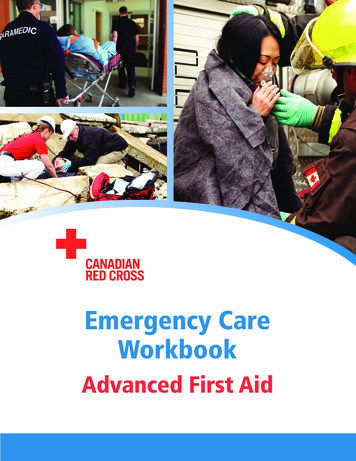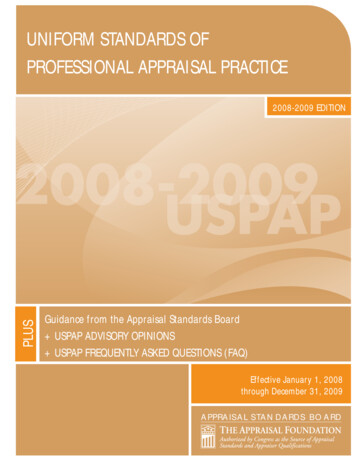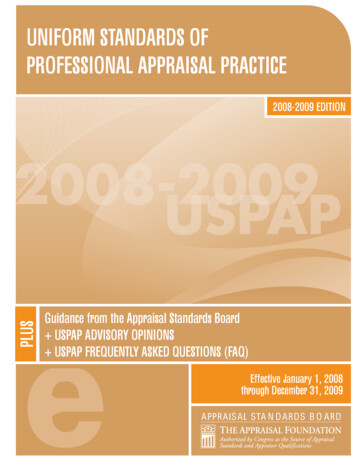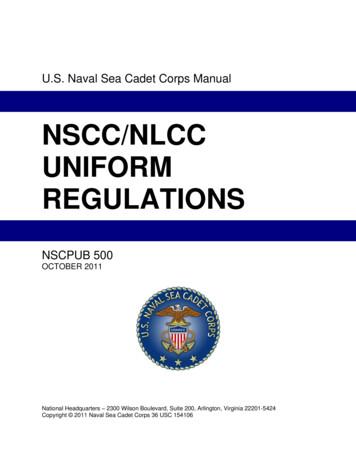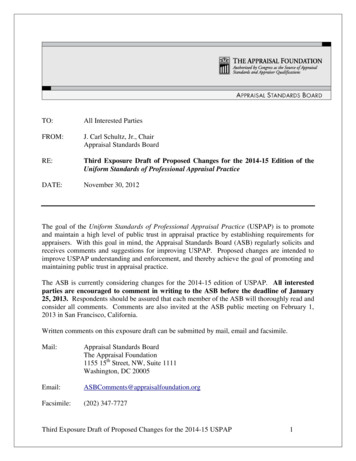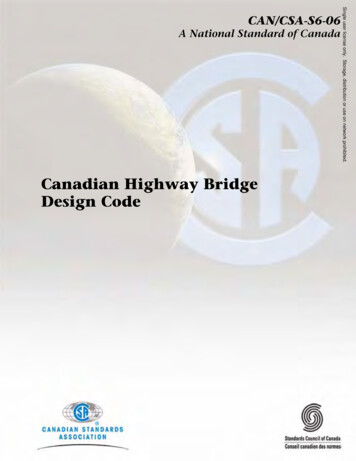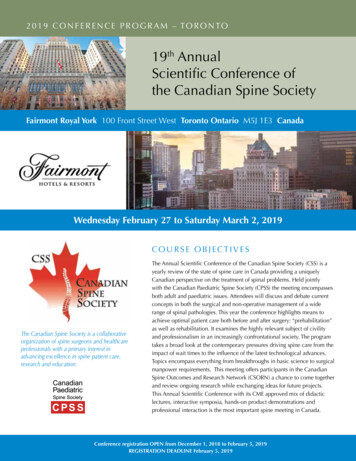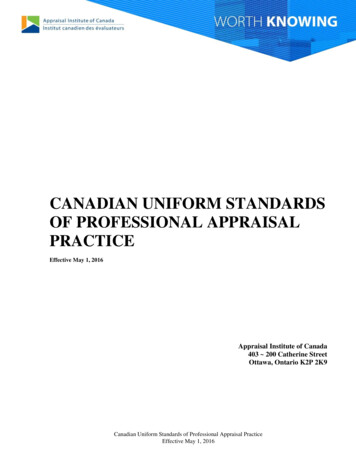
Transcription
CANADIAN UNIFORM STANDARDSOF PROFESSIONAL APPRAISALPRACTICEEffective May 1, 2016Appraisal Institute of Canada403 200 Catherine StreetOttawa, Ontario K2P 2K9Canadian Uniform Standards of Professional Appraisal PracticeEffective May 1, 2016
TABLE OF CONTENTS1INTRODUCTION . 12DEFINITIONS . 33FOREWORD . 164ETHICS STANDARD - RULES . 185ETHICS STANDARD – COMMENTS . 206REAL PROPERTY APPRAISAL STANDARD RULES . 307REAL PROPERTY APPRAISAL STANDARD – COMMENTS . 328REVIEW STANDARD - RULES . 439REVIEW STANDARD – COMMENTS. 4610CONSULTING STANDARD - RULES . 5311CONSULTING STANDARD – COMMENTS. 5412RESERVE FUND PLANNING STANDARD - RULES . 5913RESERVE FUND PLANNING STANDARD - COMMENTS . 6114MACHINERY AND EQUIPMENT APPRAISAL STANDARD - RULES . 6815MACHINERY & EQUIPMENT APPRAISAL STANDARD – COMMENTS . 7016PRACTICE NOTES . 8017PROFESSIONAL EXCELLENCE BULLETINS . 13818APPENDIX A - INDEX . 13919APPENDIX B - CHANGES TO CUSPAP FROM 2014 EDITION . 143Canadian Uniform Standards of Professional Appraisal PracticeEffective May 1, 2016
1. Introduction1 INTRODUCTIONThis 2016 edition of the Canadian Uniform Standards of Professional AppraisalPractice (“The Standards,” or CUSPAP), first introduced in January 2001, respects theexpanding role of the valuation professional within the Appraisal Institute of Canada(“AIC” or “the Institute”). The Standards endorse International Valuation Standards asan authority promoting world-wide acceptance of standards for property valuation.With the advent of International Financial Reporting Standards (IFRS) and thetransition within Canada to International Accounting Standards (IAS) in 2011, theBoard of Directors of the AIC has recognized the need for valuation standards thataddress emerging valuation requirements for International Financial ReportingStandards (IFRS) and diversification of the scope of work available to AIC Members.The Standards contained in this edition are compliant with the International ValuationStandards (IVS) published by the International Valuation Standards Council (IVSC).Members of the Appraisal Institute of Canada accepting assignments under theInternational Financial Reporting Standards (IFRS) must, in addition to CUSPAP,obtain and be familiar with the current edition of the International Valuation Standards– specifically the General Standards (IVS 101, 102 and 103) and applicable AssetStandards (IVS 220 – Plant and Equipment, IVS 230 – Real Property Interests and IVS233 – Investment Property under Construction). Additionally, Members must obtainand be familiar with the Valuation Applications sections for specific valuationsituations, specifically IVS 300 – Valuations for Financial Reporting and IVS 310 –Valuations of Real Property Interests for Secured Lending.Definitions [see section 2] form an integral part of the Standards; for the purpose ofthese Standards, their application is compulsory.CUSPAP encompasses Six Standards, each containing compulsory Rules andComments and, where relevant, non-compulsory Practice Notes (section 16) andProfessional Excellence Bulletins (section 17) where applicable: Ethics Standard [see section 4 (Rules) and section 5 (Comments)] Real Property Appraisal Standard [see section 6 (Rules) and section 7(Comments)] Review Standard [see section 8 (Rules) and section 9 (Comments)] Consulting Standard [see section 10 (Rules) and section 11 Comments)]Canadian Uniform Standards of Professional Appraisal PracticeEffective May 1, 2016Page 1 of 150
1. Introduction Reserve Fund Planning Standard [see section 12 (Rules) and section 13(Comments)] Machinery and Equipment Appraisal Standard [see section 14 (Rules) andsection 15 (Comments)]The Member is required to comply with the applicable legislative and/or licensingrequirements for all types of professional services assignments. In some jurisdictions,legislation may limit or expand the qualifications of the practitioner and legislationsupersedes CUSPAP.The Member who is qualified under more than one valuation organization and whosework is required to comply to more than one standard of practice must ensure thatadherence is to the highest minimum standard.Where two standards conflict, Members must comply with CUSPAP - it is theMember’s responsibility to determine their obligations to comply with any otherstandard.For any questions related to CUSPAP, Members may consult with AIC’s Director,Professional Practice at directorprofessionalpractice@aicanada.ca or toll free at (866)726-5996.Canadian Uniform Standards of Professional Appraisal PracticeEffective May 1, 2016Page 2 of 150
2. Definitions2 DEFINITIONSDefinitions form an integral part of the Standards and for the purpose of theseStandards, their application is compulsory:AACI:Accredited Appraiser Canadian Institute designation. [see 2.22.1, 5.1.2, 5.1.3, 5.5.5,]AIC:Appraisal Institute of CanadaACCRUED DEPRECIATION:The difference between an improvement’s cost new and its value as of any given date.[see 7.15.5.iii, 15.13.5.ii, 16.65.1.viii]Note: For Reserve Fund Studies – Accrued Depreciation: The estimated differencebetween a components replacement cost new and the fraction of life utilized to date.Calculated as Replacement Cost x Effective Age / Useful Life.APPRAISAL:A formal opinion of value, either written or oral, prepared as a result of a retainer,intended for reliance by identified parties, and for which the signing appraiser assumesresponsibility. [see 6.2.24]Note: A formal opinion of value is not an appraisal if it is not the result of a retainer, ifit is not intended to be relied upon, and if it is one for which the Member would not beexpected to accept responsibility.Note: APPRAISAL is also defined as the act or process of developing an opinion ofvalue.APPRAISAL PRACTICE:Generic term to describe the work or services performed by Members, defined by thefive activities in these standards: real property appraisal, review, consulting, reservefund planning and machinery and equipment appraisal.Note 1: These five activities are intentionally generic, and not mutually exclusive.For example, an estimate of real property value may be required as part of a review,consulting, reserve fund and machinery and equipment valuation service.Note 2: The use of other nomenclature by the Member (e.g. analysis, counselling,evaluation, study, submission, valuation) does not exempt the Member fromCanadian Uniform Standards of Professional Appraisal PracticeEffective May 1, 2016Page 3 of 150
2. Definitionsadherence to these standards. To avoid any confusion in the event of a claim, it isrecommended that CUSPAP terminology be used for consistency of practice.ASSOCIATE MEMBER:Shall be a person admitted to the Institute and enrolled on the register of the Institute asan Associate, and who is not eligible for any other Membership category in theInstitute. [see 16.1.5]ASSEMBLAGE:The merging of adjacent properties into one common ownership or use. [see 6.2.18]ASSIGNMENT:A professional service provided as a result of a retainer or agreement between aMember and client.ASSUMPTION:That which is taken to be true. [see 6.2.9, 8.2.7, 10.2.8, 12.2.9, 16.28]BIAS:A preference or inclination not reasonably supported either used in the development orcommunication of a real property appraisal, review, consulting, reserve fund planningor machinery and equipment appraisal assignment that precludes a Member’simpartiality, or favoring or promoting the cause or interest of the client, the Member oranother party. [see 7.24, 9.8, 11.1, 11.10, 16.7.9, 16.9]CANDIDATE MEMBER:An AIC fee or non-fee Candidate Member shall be a person admitted to the Institutewho is of legal age and has not completed the requirements for any designation; a CRAdesignated Member working toward the achievement of the AACI designation is notconsidered a Candidate. A Candidate Member (fee or non-fee) whose work is co-signedmust be properly registered by their co-signing designated Member(s) in AIC’sCandidate Co-signing Registry. [see 2.18, 5.1, 5.4]CHATTEL:A tangible and movable item that is not a fixture may be personal property, and may beincluded with the realty. [see 7.8.1.iv]Canadian Uniform Standards of Professional Appraisal PracticeEffective May 1, 2016Page 4 of 150
2. DefinitionsCLIENT:The client is the individual or organization for whom the Member renders professionalservices. The client is typically the intended user of the assignment. [see 6.2.1, 8.2.1,10.2.1, 12.2.1, 16.12]COMPETENCE:Having sufficient knowledge, skill and experience required to perform a specificassignment. [see 4.3.7, 16.8]CONFIDENTIAL INFORMATION:Information, not otherwise publicly available, provided in the trust that the recipientwill not disclose it to a third party. [see 5.10.4, 16.7.6.ii]CONSULTING:The act or process of analysis of data and provision of recommendations or conclusionson diverse questions or problems involving real estate, and/or machinery andequipment; the scope of this type of professional service differs from appraisal orreview assignments. [see 10, 11, 12, 13]CONTINGENT FEE:Compensation that is dependent on the result or outcome.CO-SIGNATURE:Personalized evidence indicating authentication of the work performed by the Membersas joint authors, where each is responsible for the content, analyses, and conclusions inthe report. A designated Member cannot co-sign a report with a student or nonMember. [see 2.11, 5.4, 5.8, 7.25, 9.9.1, 9.9.5, 12.2.20, 16.38]Note: A signature can be represented by a handwritten mark, a digitized imagecontrolled by a personalized identification number, or other media, where the Memberhas sole control of affixing the signature or has delegated the affixing of their signatureto a third party (e.g., staff, another designated Member). Where delegation occurs,written confirmation of the delegation must be kept in the workfile.COUNCIL:The Board of Directors of the Appraisal Institute of Canada.Canadian Uniform Standards of Professional Appraisal PracticeEffective May 1, 2016Page 5 of 150
2. DefinitionsCRA:Canadian Residential Appraiser designation granted by the AIC to a Member who hasfulfilled all requirements of the designation. A CRA-designated Member workingtoward the achievement of the AACI designation is not required to be registered inAIC’s Candidate Co-signing Registry. [see 2.11, 2.17, 2.22, 5.1.3, 5.5.3, 5.5.4, 5.5.5,16.1.1]DEPRECIATION:A loss in property value from any cause.Note: Reserve Fund Study Depreciation- Depreciation relates to the component andits replacement cost only and does not have a relationship with the property value.DESIGNATED MEMBER:Shall be a person admitted to the Institute and enrolled on the register of the Institute asholding one of the following grades or ranks, as conferred by the Board of Directorsupon any person who has complied with the requirements for their use:Accredited Appraiser Canadian Institute (AACI) [see 2.1]Professional Appraiser (P. App) [see 2.51]Canadian Residential Appraiser (CRA) [see 2.20]Professional Valuator (P. Val.)EFFECTIVE DATE:The date at which the analyses, opinions and conclusions in an assignment apply. Theeffective date may be different from the inspection date and/or the report date. [see6.2.6, 7.6, 8.2.4, 10.2.5, 12.2.6, 15.6]EXPOSURE TIME:Is referred to in most market value definitions. In an appraisal, the term means theestimated length of time the property interest being appraised would have been offeredon the market before the hypothetical consummation of a sale at the estimated value onthe effective date of the appraisal.A retrospective estimate based upon an analysis of past events assuming a competitiveand open market. It is always presumed to have preceded the effective date of theappraisal. It may be expressed as a range, and should appear in that section of the reportthat presents the discussion and analysis of market conditions, and with the final valueconclusion.Canadian Uniform Standards of Professional Appraisal PracticeEffective May 1, 2016Page 6 of 150
2. DefinitionsExposure time is different for various types of real estate and under various marketconditions. Rather than appear as an isolated estimate of time, it must refer to theproperty appraised, at the value estimated. The overall concept of reasonable exposuretime encompasses not only adequate, sufficient and reasonable time, but also adequate,sufficient and reasonable marketing effort. The distinction between exposure time (i.e.,past) and marketing time (i.e., future) must be made clear if both are referred to in thereport.Note: Marketing time is defined as the estimated length of time the property interestwould have to be offered on the market before actual consummation of a sale at theestimated value after the effective date of the appraisal.EXTERNAL VALUER:An Appraiser who is an agent acting on behalf of the client and has no material linkwith the client or the subject of the assignment. [see 2.39]Note: This is a term referred to in IVS and used in valuation for financial reporting.There is no relation to AIC fee and non-fee appraisal categories, or reference toappraisal of any purpose other than financial reporting to indicate that the personwriting the report is at arm’s length to the Client.EXTRAORDINARY ASSUMPTION:An assumption, directly related to a specific assignment, which, if found to be false,could materially alter the Member’s opinions or conclusions. [see 7.9.1, 7.9.2, 7.10.4,9.5.4, 13.9, 13.10, 16.28]EXTRAORDINARY LIMITING CONDITION:A necessary modification or exclusion of a Standard Rule which may diminish thereliability of the report. [see 7.9.2, 13.9.3, 16.19.2, 16.27.6, 16.30]FEASIBILITY ANALYSIS:A study to assess whether a project will develop according to the expectations of theclient and is economically feasible in accordance with the client’s explicitly definedfinancial objectives. [see 11.9, 16.45]FEE APPRAISER:A fee appraiser is a Member who provides any professional real property appraisal,review, consulting, reserve fund planning or machinery and equipment appraisalservices in Canada on a fee-for-service basis (whether the fee is paid to the Member orto the Member’s employer), and/or where the product of the service may be provided toany party other than the Member’s employer, firm, partnership or corporation. [see 2.4,2.16, 2.53, 2.61, 2.63, 5.8]Canadian Uniform Standards of Professional Appraisal PracticeEffective May 1, 2016Page 7 of 150
2. DefinitionsNote: The AIC Professional Liability Insurance policy specifically defines the term as:A Member who renders Professional Services on a fee-for-services basis in Canada; or;is an employee who provides Professional Services on behalf of his/her employer orcontracting partnership or corporation or sole proprietorship for which a fee is paid tothe employer or contracting partnership or corporation and/or employee.FIXTURE:An improvement or personal property that is attached to the land or building in apermanent manner, is essential to the real estate and is an integral part of the building.A Member must have the competence to ascertain whether the fixture is animprovement, personal property, or a trade fixture and the contributory value of thefixture, if any.FORCED SALE VALUE:A term synonymous with “liquidation value”, “distress sale” or “power of sale”implying a reduced selling period and compulsion to sell. Forced sale value is not aconcept separate from market value but is a form of marketing conditions lessfavourable to the seller than those set out in the definition of market value. [see 16.14]Note: Some valuation standards do not allow the use of the term “Forced Sale Value”or similar; in these instances, the higher minimum Standard prevails. [see 1Introduction]HAZARDOUS SUBSTANCE:Any material within, around, or near the property in question that has sufficient form orquantity and exhibits any hazardous characteristics that can create a negative impact onvalue. Such substances shall include, but are not limited to, solids, liquids, gaseous orthermal irritants, contaminants or smoke, vapour, soot, fumes, acids, alkalis, chemicals,or waste materials.HIGHEST AND BEST USE:The reasonably probable use of real property, that is physically possible, legallypermissible, financially feasible and maximally productive, and that results in thehighest value. [see 6.2.13, 16.27.1 16.31, 16.32]HYPOTHETICAL CONDITION:That which is contrary to what exists, but is supposed to exist for the purpose ofanalysis. A Hypothetical Condition requires there to be an Extraordinary Assumption inthe report. [see 6.2.10, 10.2.9, 12.2.10, 16.29, 16.30, 16.57]INSTITUTE:The Appraisal Institute of Canada and its authorized Committees.Canadian Uniform Standards of Professional Appraisal PracticeEffective May 1, 2016Page 8 of 150
2. DefinitionsINTANGIBLE PROPERTY (INTANGIBLE ASSETS):Non-physical assets, including but not limited to franchises, trademarks, patents,copyrights, goodwill, equities, mineral rights, securities, and contracts, as distinguishedfrom physical assets such as facilities and equipment.INTENDED USE:The use of a Member’s professional services, as identified by the Member based oncommunication with the client. [see 6.2.2, 8.2.2, 10.2.2, 12.2.2, 16.13]INTENDED USER:The client and any other party, as identified by name, as a user of the professionalservices of the Member, based on communication between the Member and the client.[see 6.2.1, 8.2.1, 10.2.1, 12.2.1, 16.12]INTERNAL VALUER:An appraiser who is in the employ of either the entity that owns the assets or theaccounting firm responsible for the preparing the entity’s financial records and/orreports. Members who are internal valuers are also referred to the IVS. [see 2.24]Note: A term referred to in the IVS and used in valuation for financial reporting. Thereis no relation to AIC fee and non-fee appraisal categories, or reference to appraisal ofany purpose other than financial reporting.INVESTMENT ANALYSIS:A study that reflects the relationship between acquisition price and anticipated futurebenefits of a real estate investment. [see 11.8, 16.44]INVESTMENT ANALYSIS - RESERVE FUND STUDY:For reserve fund studies, an investment analysis consists of analyzing the rate of returnpreviously achieved by the client with their reserve fund, along with determining anestimated rate of return that might be achieved in the future in accordance withlegislation (if legislation is applicable). The investment analysis must be conveyed insuch a manner so as not to be construed as the Member providing “investment advice”.JURISDICTIONAL EXCEPTION:An assignment condition that permits the Member to disregard a part or parts of theseStandards that are determined to be contrary to law or public policy in a givenjurisdiction; only that part shall be void and of no force or effect in that jurisdiction.[see 5.4.16, 7.10.6, 15.10.5, 16.10.6, 16.38.8, 16.48.2, 16.53]Jurisdiction relates to the legal authority to legislate, apply or interpret law at either thefederal, provincial or local levels of government. In the report the Member mustCanadian Uniform Standards of Professional Appraisal PracticeEffective May 1, 2016Page 9 of 150
2. Definitionsidentify the part or parts of CUSPAP disregarded as well as the law, regulation or legalauthority that precludes compliance to CUSPAP.In every case, it is ultimately the responsibility of the Member, not the client or otherintended users, to determine whether the use of Jurisdictional Exception is appropriate.It is unethical for a Member to complete an assignment that a Reasonable Appraisercould not support.LEASE:A legal agreement which grants right to use, occupy, or control all or part of a property,to another party, for a stated period of time based on the terms and covenants of thelease including, among other things, the rental rate. [see 6.2.17, 16.29.2.ii, 16.30.5,16.30.5.i]LIMITING CONDITION:A statement in the report identifying conditions that impact the conclusion. [see 6.2.9,7.9, 8.2.7, 10.2.8, 12.2.9, 16.28, 16.30.2]MACHINERY & EQUIPMENT DEFINITIONSNote: Machinery and Equipment: A term that describes the physical facilitiesavailable for production, including the installation and service facilities, together withall other equipment designed or necessary for manufacturing purposes, regardless of themethod of installation. It also includes those items of furniture and fixtures necessaryfor the administration and proper operation of the enterprise. [see 14]Note: Equipment: includes all machinery and other apparatuses or implements used inan operation or activity (all machinery is equipment, but all equipment is notnecessarily machinery). [see 14]Note: Equipment Classes: typical equipment classes are production machinery;support equipment; motor control centers and switchgear; power wiring; process piping;foundations and structural supports; material handling and storage equipment; generalplant equipment; plant and motor vehicles; laboratory and test equipment; officefurniture, fixtures, and equipment; computer equipment; tools; special tooling; patternsand templates; construction in progress; special classes; and inventory. [see 14]Note: Furniture: a particular type of equipment utilized in ancillary functions of anoperation. It is designed to provide a convenient and efficient work location forpersonnel or necessary storage facilities. [see 14]Note: Machinery: the term encompassing man-made mechanical devices, usuallyelectrically powered, that are designed to create a product or in some manner alter thestate of a material or partial product. [see 14]Canadian Uniform Standards of Professional Appraisal PracticeEffective May 1, 2016Page 10 of 150
2. DefinitionsNote: Trade Fixtures: Fixtures utilized for the purpose of carrying on a trade orbusiness. In a retail operation, they are sometimes considered specialized furniture orfixtures designed to display products. [see 14]MARKET ANALYSIS:A study of real estate market conditions for a specific type of property. [see 11.7, 11.9,16.43, 16.45]MASS APPRAISAL:The process valuing a universe of properties as of a given date utilizing standardmethodology, employing common data, and allowing for statistical testing.MEMBER:A term used throughout CUSPAP and shall refer to a Designated Member or CandidateMember.NON-FEE APPRAISER:A non-fee appraiser is a Member who provides any professional services exclusivelyfor the internal use of his/her employer and whose real property appraisal, review,consulting, reserve fund study and/or machinery and equipment appraisal (professionalservices) reports are kept in-house and are not provided to an outside party, although afee may be paid by that outside party to cover the cost of the preparation of the report.Notwithstanding the above, government and crown corporation employees may registeras non-fee appraisers, (including those who are employed by one governmentdepartment but provide professional services to other governments, governmentdepartments or government-owned corporations), whether or not a fee is paid for theservices provided. [see 2.4, 2.16, 2.53, 2.61, 2.63, 5.8, 16.38.6]Note 1: Notwithstanding that the AIC Professional Liability Insurance Policyspecifically defines non-fee appraiser as noted above, a Member who is temporarilyunemployed or holding employment that does not relate to professional services mayregister as a non-fee appraiser for the period during which he/she is not providing anyprofessional services.Note 2: The AIC Professional Liability Insurance Policy specifically defines Non-FeeAppraiser as a Member who renders Professional Services exclusively for the internaluse of his or her Employer.OCCUPANT:The occupant is described as the person who has the right to occupy a unit or space (e.g.rental apartment, condominium unit, residential dwelling, office space).Canadian Uniform Standards of Professional Appraisal PracticeEffective May 1, 2016Page 11 of 150
2. DefinitionsP. App:Professional Appraiser Designation. [see 2.22] This designation can only be used byAACI designated Members in conjunction with the AACI designation.PERSONAL PROPERTY:Identifiable portable, tangible or intangible objects considered or defined as being"personal”. Examples of classes of personal property include, but are not limited to:furnishings, artwork, antiques, gems and jewelry, collectibles, machinery andequipment; all property, tangible and intangible, that are not classified as real property.[see 6.2.20]PROFESSIONAL ASSISTANCE:Professional assistance involves support to the Member that has a direct and significantbearing on the outcome of his or her assignment. A Member may rely on significantprofessional, appraisal, review, consulting or reserve fund planning assistance of anemployee. Such assistance would generally be provided by insured Members of theInstitute or other professionals. Inspection of a property is professional assistance as itforms part of the analysis leading to an opinion. [see 16.15]PROFESSIONAL SERVICES:Means real property appraisal, review, consulting, reserve fund planning, andmachinery and equipment appraisal services which were rendered, or which shouldhave been rendered, by a Member, and for which such Member was, at the time ofproviding said services, qualified, competent and authorized under the Rules, By-laws,Regulations and CUSPAP to undertakePURPOSE:The purpose of the assignment as it relates to the client’s intended use of the report.REAL ESTATE:Land, buildings, and other affixed improvements, as a tangible entity. [see 10.2.4]REAL PROPERTY:The interests, benefits, and rights inherent in the ownership of real estate. [see 7.8, 10.1,10.2.4]Note: In some jurisdictions, the terms real estate and real property have the same legalmeaning. The separate definitions recognize the traditional distinction between the twoconcepts in appraisal theory.Canadian Uniform Standards of Professional Appraisal PracticeEffective May 1, 2016Page 12 of 150
2. DefinitionsREASONABLE APPRAISER:A Member providing professional services within an acceptable standard of skill andexpertise, and based on rational assumptions. [see, 7.1.2, 7.14.2, 7.15, 9.1.2, 11.2.2,13.1.2, 16.15, 16.38.1]Note: For the purposes of CUSPAP and the Professional Liability Insurance Program,the term appraiser, when employed or referenced outside of the Real Property AppraisalStandard and Machinery & Equipment Appraisal Standard, is deemed to be generic andsynonymous to “AIC Member”, “the Member”, “the practitioner”, “the reviewer”(under the Review Standard”), “the Consultant” (under the Consulting Standard”, “thereserve fund planner” (under the Reserve Fund Standard”).RECERTIFICATION OF VALUE:An inspection performed to confirm whether or not the hypothetical conditions in theappraisal have been met. [see 7.10.3]REPORT:Any communication, written or oral, of a professional service that is transmitted to theclient as a result of an assignment. [see 7.1, 9.1, 11.2, 13.1, 16.10, 16.12]Note 1: Most reports are written and most clients mandate written reports. Oral reportrequirements are included to cover court testimony and other oral communications of areal property appraisal, machinery & equipment appraisal, review, consulting, orreserve fund planning service.Note 2: These Standards do not dictate the format or style of reports. The substantivecontent of a report determines its compliance with CUSPAP.Note 3: Report types may include form reports, concise short narrative reports or,comprehensive and detailed reports in complete or draft formats. Letters of opinion arenot acceptable report types.RESERVE FUND STUDY:A budget planning tool which identifies the current status of the Reserve Fund and aFunding Plan to offset the anticipated expenditures for the major repairs andreplacement of components, elements or assets, for which the corporation or associationis responsible. The Reserve Study consists of two parts: the Physical Analysis and theFinancial Analysis Reserve Fund Study, Depreciation Study, Depreciation Reports,Contingency Reserves (“Reserve Fund Study”) are synonyms for the purpose of thisstandard. [see 12, 13]. The output of a reserve fund study is not a “value” as defined inDefinition 2.69 (Value).Canadian Uniform Standards of Professional Appraisal PracticeEffective May 1, 2016Page 13 of 150
2. DefinitionsRETAINER:A term used throughout CUSPAP and shall refer to the engagement of a Member by aclient to produce a formal report for an intended use.REVIEW:The act or process of developing and communicating an opinion about all or part of areal property appraisal, machinery & equipment apprai
1. Introduction Canadian Uniform Standards of Professional Appraisal Practice Effective May 1, 2016 Page 1 of 150 1 INTRODUCTION This 2016 edition of the Canadian Uniform Standards of Professional Appraisal Practice (“The Standards,” or CUSPAP), first introduced in January 2001, respects the expanding role of the valuat
